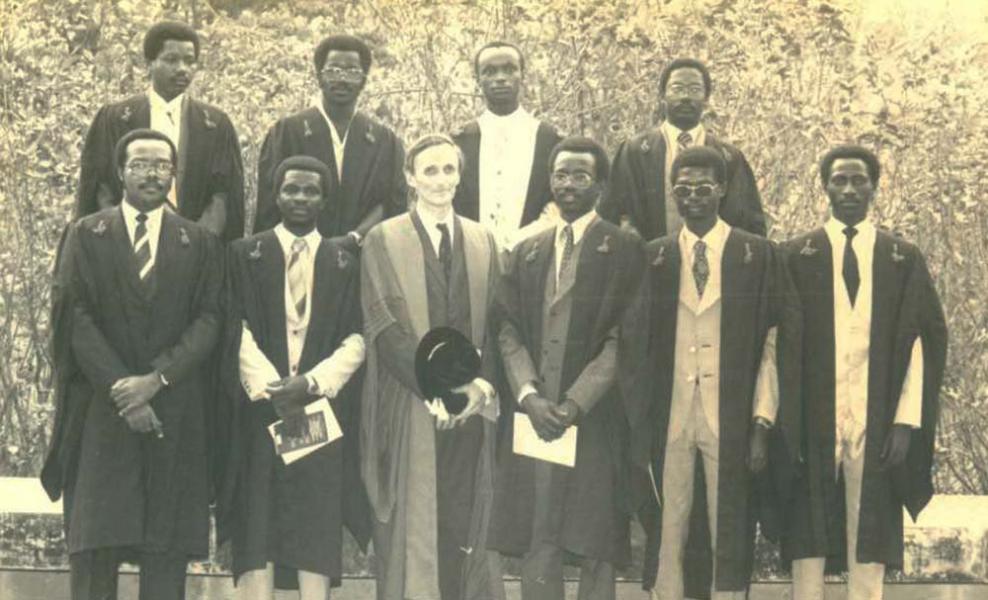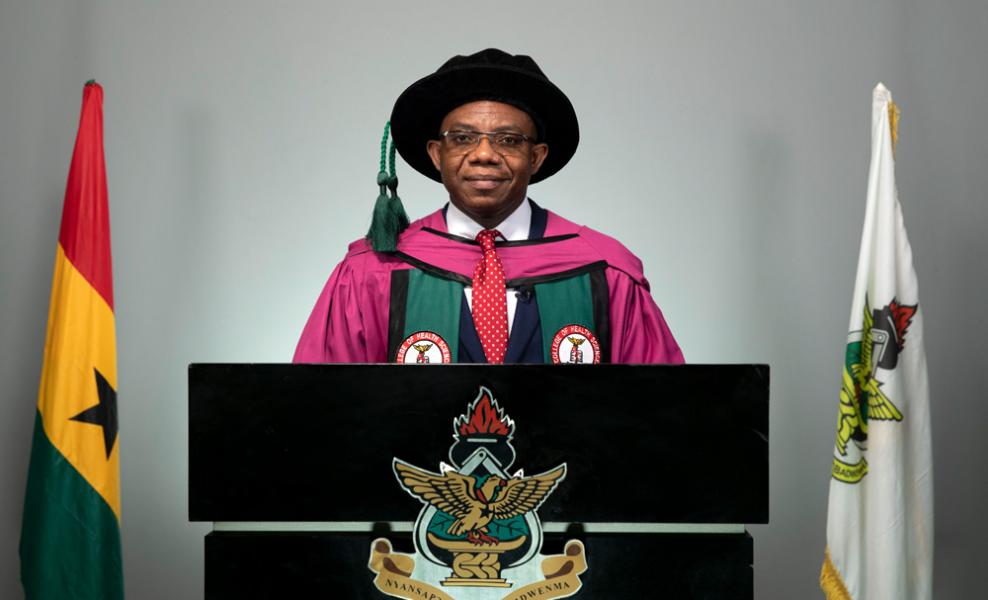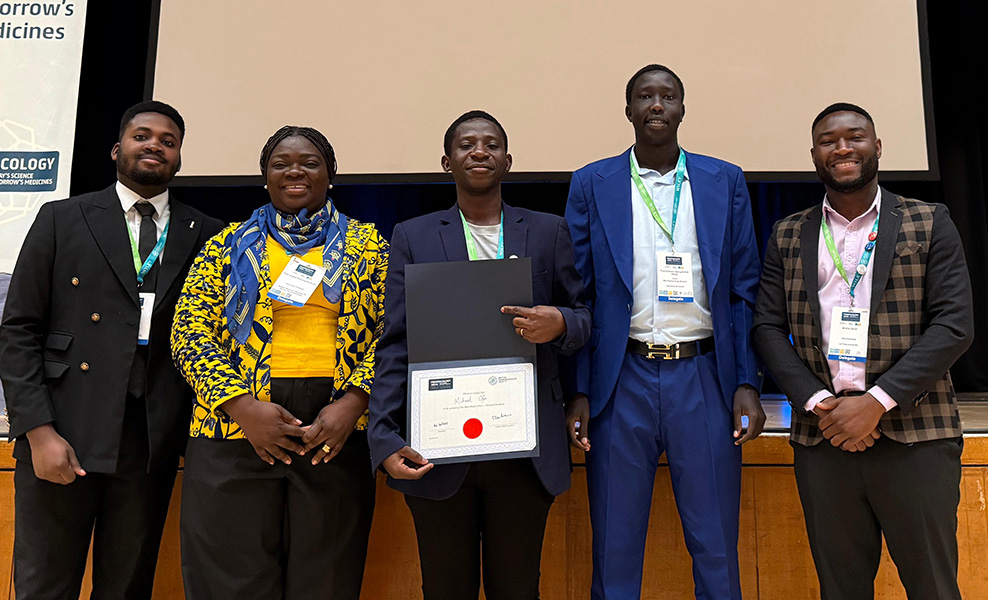Memoirs from KNUST SMS Pioneers

A group of twenty-six young Ghanaians made up of 22 males and four females turned up at the University of Science and Technology in October 1975 to honor the offered admission into the newly opened School of Medical Sciences (SMS). Since there were no physical structures for the new school, the first meeting occurred in the senior common room of Independence Hall. We were then given a brief on how our training would proceed.
We joined first-year students in the Science Faculty for our Physical Chemistry by Dr. Rao and General Chemistry by Dr. Newton. The late Professor Quartey from the University of Ghana (UG) flew in from Accra every week to teach us Organic Chemistry. We had to walk from the Science Faculty to the General Auditorium to join the second-year science students for statistics, and then have a separate lesson in Plant Systematics, Cell Biology/Genetics, and Parasitology at the Biological Sciences Department near the Faculty of Art which was at the opposite end of where our other classes were. These lectures were given by many experienced lecturers including Dr. Opuni and Prof. Stamp. Our lectures were scattered all over the vast UST campus. Some of our classes were combined with students from other faculties, and we often arrived at some of these classes late and missed big chunks of lectures delivered. Later that year the school acquired the famous crimson red Neoplan bus which helped with the transportation between the various lecture sites. Our first year was also enriched by classes in sociology. We cannot forget the glorious afternoon towards the end of 1975 when we were invited by the Mayor of Kumasi, Nana Akwasi Agyeman, for a lecture on environmental science, which ended with him showering us with “essential commodities”, groceries not easily available in the grocery stores in those days. The long vacation was filled with a class in Medical Sociology taught by Professor Twumasi from UG.
The second year was the most challenging since the school had no full-time staff to teach the required disciplines of Anatomy (including Embryology), Biochemistry, and Physiology. Lecturers from the Faculty of Science took up lectures in Biochemistry including Dr Leggett Bailey from the United Kingdom. Dr. Lutherodt from the Pharmacy Faculty took lectures in Embryology and part of Physiology, the late Professor Roger Lewis who had joined SMS from UGMS helped with Physiology, and two late surgeons, Professor Bossman, and Professor Hiadzi provided lectures in Anatomy. As part of our Anatomy/Pathology experience, the first Dean of SMS, Professor W. N. Laing, once sent us to Tafo Cemetery, to observe the autopsy of a Coroner’s case. The stench from the decomposed cadaver was awful resulting in some members of the class becoming temporary vegetarians. The end of second-year examinations were a disaster with about half the class failing Anatomy. This failure event renewed calls to close the school and possibly send students to the University of Ghana Medical School (UGMS) for continuation of their training. The government of the day with the support of the then Asantehene, the late Nana Opoku Ware II, stood their ground for the school to continue. Lecturers from UGMS and other resources were brought from UGMS to help with remedial classes for Anatomy and the re-sit examination was successful which emboldened the continuation of the school.
The third year was less dramatic since the school had more structure by then. The subjects to be studied had experienced lecturers with professors from the Faculty of Pharmacy and the late Professor Roger Lewis taking the Pharmacology slot, the Dean himself, a guru in Pathology taking us in Pathology, assisted by Prof Goodall, Dr. Harding taught Chemical Pathology, and Dr. Nyarko from the Faculty of Science Microbiology. Thankfully, there was no drama from the end of the third-year examination with a total of sixteen of us acquiring our BSc (Human Biology) degree.
However, during the 1978 UST convocation, all the 16 graduands walked out of the Great Hall to register our disagreement with the school’s decision to award classes for BSc. degree based on UST examination marking scheme whereas SMS had all along adopted a closed marking scheme which was unlike the UST system.
After the BSc (Human Biology) degree program, we started the fourth year (first clinical year) with no clear program since the Medical and Dental Council (MDC) Assessment of Komfo Anokye Hospital was that the facility was not suitable for medical training. The most indicting statement was that the hospital needed 'soap and water' to make it fit to be used for teaching. We the pioneer students were left in limbo with us spending some of the early period of that year in our residential halls; this led our fellow university students to coin the name “School of Maximum Soma” as an interpretation of our acronym SMS.
Things did not remain the same for long as we soon started with Clinical Methods and clerking patients at the Chirapatre Polyclinic now named Kumasi South Hospital with Prof Hutton Addy. Dr. Dr. Brobbey who had just joined SMS and who later became the Dean also took part in teaching us how to clerk patients. The Dean and his staff were determined to start the clinical program in Kumasi, and we the student pioneers were in full support. Unfortunately, because of the economic stress the country was in, the needed interventions suggested by the MDC team to address the identified shortcomings were not forthcoming from MOH. The idea of going sending the students to Korle Bu, Accra, which had come up a couple of years earlier, started gaining ground. Finally, after almost six months of “maximum soma” 17 of the pioneers including a graduate student who had joined from the USA for clinical training had to leave for Korle Bu, Accra.
Even though our travel from Kumasi to Accra was uneventful despite the numerous military checkpoints post the 1979 AFRC Revolution, our arrival at Korle Bu, Accra, was full of drama since there was no sleeping space accommodation for us in the Medical Students hostel. After some lengthy delay, we were led to the Boys Quarters (BQ) of the newly constructed housemen flats and provided empty rooms with no beds and mattresses but with mats on the floor. The furniture for our rooms was delivered piecemeal over several weeks and we had to sleep on mats on the floor in the early days.
When we got to Korle Bu, our peers from UGMS were about six months ahead in their clinical training. The lecturers at UGMS initially had the impression that we were not adequately prepared but after giving us several exams that our peers took, we all performed very well, surprising them. They then decided that we were indeed adequately prepared and would be able to handle the clinical training but could not join our peers because they were too far ahead and that we join their immediate Juniors, who were also near completing their Basic Science program so a brief “maximum soma” became the tune again.
Our clinical training was uneventful since we were integrated into the UGMS without tagging our origin. as had been done initially. At the end of almost three years, we passed our final exams with the same pass rate as our colleagues from UGMS, laying finally to rest the chapter on the quality of students who came from SMS.
The decision as to which institution to award our final degrees and where to do our house jobs came up after training. It was then decided that we all come back to Kumasi for that part of the training and to be awarded degrees from UST and not the University of Ghana (UG) since we never matriculated at UG. Our first task on arrival at Komfo Anokye Teaching Hospital (KATH) was to help prepare the next batch of SMS students who were due to take their first clinical examinations in Pediatrics and Obstetrics and Gynecology with external examiners coming from UGMS since we were familiar with their way of asking questions during practical and oral examinations. This we did gracefully.
Remembering these experiences has only strengthened our determination to succeed in life. Today, we can identify some of our members who have become professors in various medical disciplines, many who are specialists, some who went through the Ghana Health Service to become Regional Health Directors, and those who set up their private medical practice and other businesses. As we go through the twilight of our lives and our profession, we hope that those who enjoy the fruits of these struggles will also take up the mantle to make this institution better than they have met it. For our colleagues who have already departed this world, we hope they enjoyed the experience as those of us left behind. Their struggles have not been in vain. To our lecturers both in SMS and UGMS, we say we are grateful for the role you played to get us where we are today, especially our dean, Prof WN Laing of blessed memory. We are happy that Asantehene Nana Opoku Ware II lived long enough to see the school solidly established before joining his ancestors.
Written on behalf of 1975 SMS Pioneers
1. George Saka Acquaye
2. Wilfred Labi Addo
3. William Adu-Krow
4. Noble Billy Agbolosu
5. Erasmus Akurugu Agongo
6. Edward Agyeman-Boateng
7. Omar Ben Ahmad
8. Yacub Ahmed
9. Dyna Carol Arhin (Miss)
10. Eugene Asante-Nimako *
11. Anane Asare-Bediako
12. Adjoa Mary Baah (Miss)
13. Francis Xavier Banka *
14. Francis Boafo
15. E. S. K. Boateng
16. Osei Kwame Bonsu
17. John Caba
18. Anthony Kwabena Cheremeh *
19. Ernest Lennox Ackah Chinbuah *
20. Kwabena Effa-Manu
21. Victor Yaw Adu Manford *
22. Francis Ensius Adu Martinson
23. Harriet Mbiah (Miss)
24. Beatrice Mensah (Miss)
25. Thomas Kofi Nukpe *
26. Emmanuel Adum Winful *









